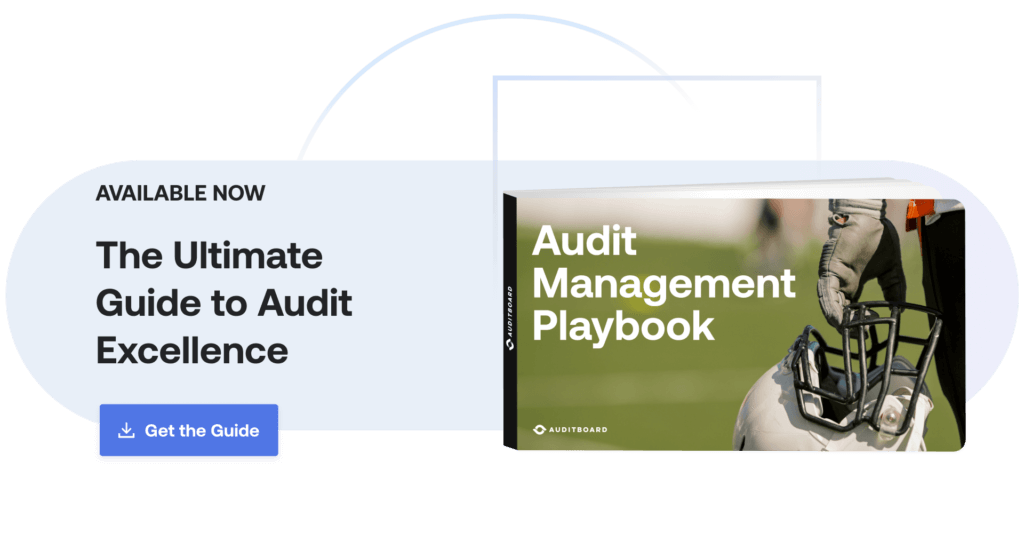
January 25, 2025 • 6 min read
Playbook: How AI and Analytics Can Scale Your Audit Program
Over the past few decades, the business world has seen significant technological advancement. In particular, the rise of AI, advanced analytics, automation, and technologies that connect teams performing assurance work enable these groups to carry out their activities more efficiently and effectively than ever before.
The effect of these technologies on the internal audit industry is apparent. When technology is successfully deployed, teams benefit from improved efficiency and collaboration, better risk insights, and more comprehensive and accurate testing results. Technology’s potential to boost internal audit’s capacity has also been called out in the updated IIA Standards, with Standard 10.3 requiring CAEs to communicate the impact of technology limitations on the internal audit function to the board and senior management.
Dive into some of the many roles AI and analytics can play in streamlining your audit, risk, and compliance programs, then download a copy of the full The Audit Management Playbook for best practices across the audit lifecycle — refreshed for 2025!
Use Cases for AI in GRC and Audit
89% of organizations plan to use AI, according to AuditBoard’s survey of over 500 InfoSec, audit, risk, and compliance leaders for The Connected Risk Report. Additionally, two-thirds of organizations that have integrated some form of AI into their risk management processes report increased efficiency, time savings, and better data analysis and insights. These benefits demonstrate AI’s potential to streamline audit, risk, and compliance processes, allowing organizations to identify and address risks more effectively while reducing manual workloads.
Technology solutions that employ machine learning (a subset of AI that uses algorithms to train on data and make recommendations or predictions) and generative AI (a subset of machine learning that generates content learned from the data on which it’s trained) offer the most compelling current evidence for AI’s ability to accelerate and enhance assurance-related activities.
Generative AI, where the AI can provide content creation and suggestions as a user types in the interface, is being used to automate a wide range of activities involving writing. Areas where GenAI has accelerated and enhanced audit programs include:
- Compliance activities, such as writing control requirements and control details
- Assurance activities, such as creating audit descriptions and worksteps
- Risk management activities, such as creating risk descriptions
- Governance activities, including narrative writing and report writing
- Issue/exception creation activities used across GRC functions
Machine learning (ML) models, which use algorithms trained on available data to emulate logical decision-making, are being used for activities such as generating intelligent recommendations based on user data, as well as detecting intrusions and malicious behavior. Areas where ML models have accelerated audit, risk, and compliance processes include:
- Suggesting mapping between controls and framework requirements
- Suggesting mapping between issues and controls, risks, and audit worksteps
- Uncovering duplicate issues in your GRC environment
- Audit or assessment evidence reuse
- Anomaly detection in controls testing
Uses for Advanced Analytics in GRC and Audit
Advanced analytics, involving the autonomous or semi-autonomous examination of data or content using sophisticated techniques and tools, enable auditors to ask insightful questions about their business and test full populations instead of just a sample. Advanced analytics’ value lies in their ability to provide more accurate testing results with significantly greater efficiency, uncover reoccurring issues in high-risk areas, enhance collaboration across all three lines of defense, and improve continuous auditing.
Out-of-the-box analytics solutions, such as AuditBoard Analytics, can streamline data management and drive efficiency, scalability, and alignment across teams in areas such as:
- Improving the accuracy of your SOX work by performing full population testing
- Automating evidence collection and testing, and performing continuous auditing with audit context, workflow certification, and version control
- Centrally managing all of your analytics and automation in one data hub
What sets great audit teams apart are forward-thinking leaders who prioritize the use of capacity-multiplying technologies such as AI and advanced analytics — but it doesn’t stop there. Use the best practices, resources, and expert advice in the fully revised Audit Management Playbook to transform your audit processes from start to finish.
You may also like to read


Top headlines that defined 2025 for internal auditors

Master your audit playbook: essential steps for internal audit teams

How the C-suite views risks and opportunities in 2026: are internal auditors poised to help?

Top headlines that defined 2025 for internal auditors

Master your audit playbook: essential steps for internal audit teams
Discover why industry leaders choose AuditBoard
SCHEDULE A DEMO




